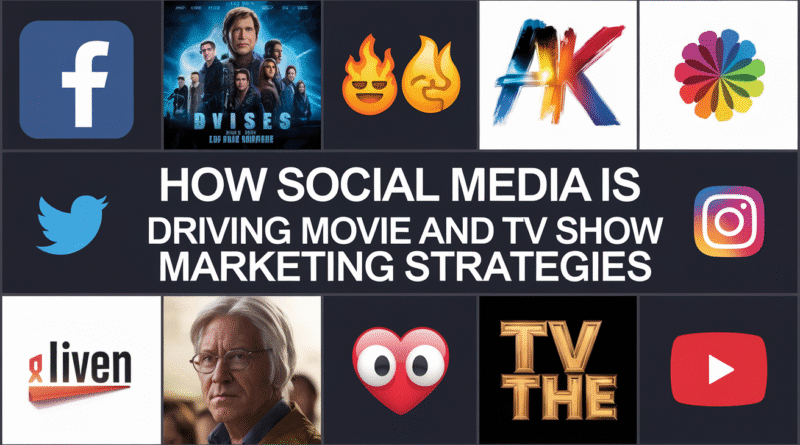How Social Media is Driving Movie and TV Show Marketing Strategies
In the modern digital landscape, social media has become a vital tool for marketers, particularly within the entertainment industry. While traditional marketing methods like billboards, trailers, and TV ads still hold relevance, social media has transformed the way marketing strategies are implemented. Platforms such as Facebook, Instagram, Twitter, YouTube, and TikTok offer direct interaction between content creators and their audiences, allowing marketers to engage with fans instantly, stir up excitement, and create organic buzz.
The appeal of social media lies in its extensive reach and interactive potential. With billions of users worldwide, these platforms provide access to large audiences and enable engagement through innovative, shareable, and interactive content. This article delves into the role social media plays in movie and TV show marketing, highlighting current trends and successful campaigns.
1. Precision Targeting Through Data
One of social media’s key advantages over traditional marketing is its ability to precisely target specific audiences. These platforms gather extensive data about users, including age, gender, location, interests, and browsing habits. For marketers promoting films or TV shows, this data is invaluable in tailoring campaigns to specific demographics.
For instance, promoting a superhero movie on Facebook or Instagram enables marketers to target fans of comic books, action films, or even particular actors. With these data-driven insights, campaigns can be more relevant to the intended audience. Similarly, platforms like YouTube serve ads based on users’ viewing history, ensuring that people who watch action movie trailers are more likely to see promotions for related films.
Case Study: Netflix’s Data-Driven Marketing
Netflix leverages data to fine-tune its marketing strategies. By analyzing user viewing habits, it not only recommends content but also promotes original shows to particular demographics through targeted social media ads. For instance, someone who watches a lot of sci-fi content may see ads for Stranger Things on Instagram or Facebook.
2. Building Anticipation with Teasers
Social media has unparalleled power in building excitement, particularly with teasers and trailers. What once aired only in theaters or on TV can now be shared online and spread globally in minutes. Social media algorithms and fan engagement enhance the reach of these trailers, making them viral sensations.
Platforms like YouTube, Twitter, and Instagram enable fans to watch, comment on, and share trailers, creating viral momentum. Studios often release teaser clips months in advance to generate early interest, with full trailers following closer to the release date.
Case Study: Marvel Studios’ Trailer Hype
Marvel Studios is renowned for its high-impact trailers. For example, when the Avengers: Endgame trailer dropped, it quickly became a trending topic and amassed millions of views in its first 24 hours. Fans broke down the trailer frame by frame, generating excitement and speculation, which boosted the film’s visibility.
3. Influencer Marketing Power
Influencers have emerged as major assets in marketing campaigns. With their large followings, influencers can shape public opinion and create buzz around films and TV shows. Partnerships with influencers often involve sponsored posts, reviews, or live-streamed events to promote new content.
These influencers can range from celebrities to social media personalities with loyal followings. Their personal recommendations resonate strongly with audiences, making promotions feel more genuine than traditional advertisements.
Case Study: Bird Box and Influencer Buzz
Netflix’s 2018 film Bird Box achieved massive success thanks to influencer marketing. Influencers on platforms like Instagram and Twitter posted memes, reactions, and reviews, which were shared by their followers. The viral “Bird Box Challenge,” inspired by the film, created significant engagement, propelling the movie into mainstream conversation.
4. Hashtags and Social Media Campaigns
Hashtags are a powerful tool for generating engagement around movies and TV shows. Memorable hashtags help studios encourage fan participation, fostering user-generated content that amplifies the marketing effort.
Studios often launch specific hashtag-driven campaigns to engage audiences in creative ways, encouraging them to share their own content—whether it be fan art, cosplay, or themed challenges—all under a branded hashtag.
Case Study: #ReleaseTheSnyderCut Movement
The #ReleaseTheSnyderCut campaign is a prime example of fan-driven marketing. Zack Snyder’s fans pushed for the release of his version of Justice League on social media, gaining enough traction to convince Warner Bros. to release the Snyder Cut on HBO Max in 2021. This illustrates the growing influence fans have on the entertainment industry through social media.
5. Interactive Content to Engage Fans
Social media provides ample opportunities for interactive content that enhances fan engagement. From polls and quizzes to behind-the-scenes footage and live Q&A sessions with actors, studios can offer a more immersive experience to fans.
Instagram Stories and Twitter polls, for example, allow fans to vote on characters or predict plot twists, creating a sense of community and excitement.
Case Study: Stranger Things Live Q&A
Netflix uses live Q&A sessions with Stranger Things cast members to promote new seasons. Fans can submit questions in real-time, fostering a direct connection with the show’s characters and building loyalty among viewers.
6. Real-Time Fan Interaction During Premieres
Social media enables studios to connect with audiences in real-time during movie premieres and TV episodes. Platforms like Twitter become conversation hubs, where fans react live to plot developments and surprise cameos. This shared viewing experience, regardless of location, enhances the sense of community.
Studios capitalize on this by creating hashtags for premieres and live-tweeting episodes, which boosts immediate engagement.
Case Study: Game of Thrones Twitter Buzz
During Game of Thrones episodes, Twitter exploded with real-time discussions and reactions. The cast and creators often joined the conversation, sharing insights and responding to fan comments, ensuring the show trended worldwide after each episode.
7. Memes and Viral Content
Memes have become a cultural phenomenon, and studios are increasingly using them as part of their marketing strategies. Social media is the birthplace of viral content, and shows or films that inspire memes can gain significant online traction.
Marketers often tap into humor or nostalgia to create memes that resonate with audiences. When these memes go viral, they keep the content in public consciousness long after its release.
Case Study: Baby Yoda and The Mandalorian
When Disney+ released The Mandalorian, Baby Yoda became an instant internet sensation. Fans generated countless memes, which spread across Twitter, Instagram, and Reddit, boosting interest in the series and contributing to its success.
Conclusion
Social media has reshaped the landscape of movie and TV marketing, offering unparalleled access to audiences and real-time interaction. Whether through targeted ads, influencer collaborations, viral content, or interactive campaigns, social media helps marketers build excitement and foster engagement on a global scale. As platforms evolve, the strategies employed by studios will continue to adapt, ensuring they remain relevant in a rapidly changing digital world. Studios that harness the power of social media will thrive, as the potential for audience engagement remains limitless.

